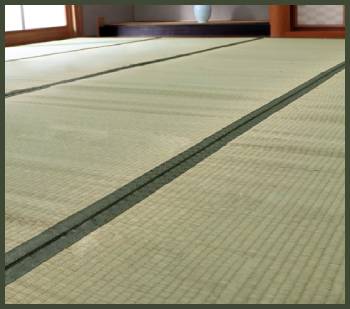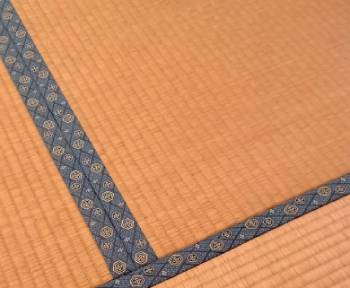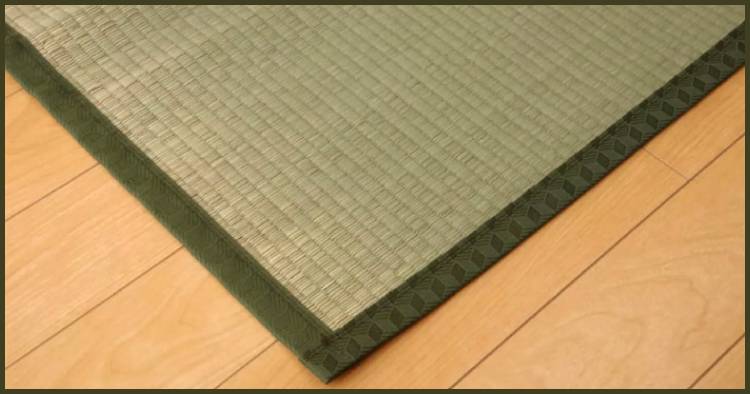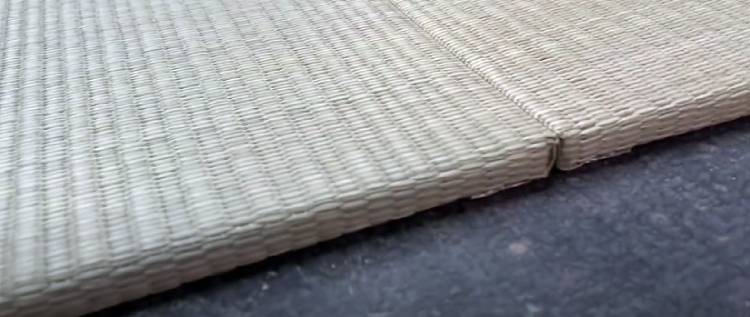I’ve always been fascinated by the serene simplicity of Japanese interiors, where every element seems to have a purpose. When I decided to bring a slice of that aesthetic into my home, I faced a choice: goza mats or tatami mats? Both are steeped in tradition, but they serve different roles.
In this article, I’ll share my experience comparing these two, exploring their features, weighing their pros and cons, and helping you decide which fits your lifestyle. Whether you’re aiming for authenticity or practicality, I’ve got you covered with insights from my own journey.
A Brief Comparison Table
A Brief Comparison Table
| Feature | Goza Mat | Tatami Mat |
| Material | Woven rush grass, no core | Rush grass over rice straw or foam core |
| Thickness | Thin (1/8 inch) | Thicker (1-2.4 inches) |
| Weight | Lightweight, easy to roll | Heavier, less portable |
| Cost | Affordable ($50-$160 for queen) | Expensive ($200-$500 for queen) |
| Primary Use | Decorative, protective layer, portable | Flooring, sleeping base, insulation |
| Durability | Moderate, prone to wear | High, long-lasting with care |
| Maintenance | Easy to clean, wipe down | Regular airing, mold prevention |
| Aesthetic | Minimalist, flexible placement | Traditional, structured layout |
| Comfort | Minimal cushioning | Firm, supportive for sleeping |
| Portability | Highly portable, rollable | Stationary, fixed in place |
My First Encounter With Goza And Tatami Mats
When I first stepped into a traditional Japanese room during a trip to Kyoto, the tatami mat beneath my feet felt like a warm handshake from history. Its firm texture and faint grassy scent were grounding.
Later, at a friend’s minimalist apartment, I noticed a goza mat casually draped over a wooden floor, adding a breezy, natural vibe.
Both mats intrigued me, but their differences sparked my curiosity. I wanted to understand which would work better for my small urban apartment back home, where space, budget, and aesthetics were all in play.
Understanding Goza Mats

Goza mats are like the lightweight cousins of tatami.
Made from woven rush grass (igusa), they’re typically just 1/8 inch thick, with no core or backing, making them flexible and rollable.
I found them surprisingly versatile—perfect for throwing over a wooden floor or even taking to a picnic.
Their simplicity is their charm; they’re often edged with a black or green cloth (tatamiberi), giving them a clean, polished look.
In Japan, goza mats are traditionally laid over tatami to protect them or used as portable floor coverings for outdoor activities. I loved their fresh, grassy scent, which reminded me of a meadow after rain. But they’re not built for heavy-duty use.
When I tried using one as a yoga mat, it felt a bit too thin for comfort, especially on my knees during downward dog.
Key Features of Goza Mats
Let’s break down what makes goza mats stand out. First, their portability is a game-changer. I could roll one up and store it in a closet when not in use, which is perfect for my small apartment. They’re also lightweight, weighing just a few pounds, so moving them around is no hassle.
The aesthetic is another plus. Goza mats bring a subtle, natural vibe that pairs well with minimalist decor. I placed one under a low coffee table, and it instantly gave my living room a Zen feel. The rush grass surface is smooth and cool to the touch, which is refreshing in summer.
Plus, they’re budget-friendly—my queen-sized goza cost me about $120 online, a fraction of a tatami’s price.
However, goza mats aren’t built for heavy use. They lack the cushioning and durability of tatami, so they’re not ideal as a primary sleeping surface. I noticed some fraying at the edges after a few months of regular use, which was a bit disappointing.
Pros of Goza Mats
I found plenty to love about goza mats. Their affordability is a huge draw—perfect for someone like me who wants a Japanese aesthetic without breaking the bank. A queen-sized goza can cost as little as $50-$160, depending on quality and size.
Their portability is another win; I’ve taken mine to outdoor gatherings, and it’s a breeze to roll up and carry.
Maintenance is straightforward. A quick wipe with a damp cloth keeps it clean, and the lack of a core means no worrying about mold unless you leave it in a damp spot. The lightweight design also makes it easy to store, which is ideal for small spaces.
And let’s not forget the fresh, grassy scent—it’s like bringing a piece of nature indoors.
Cons of Goza Mats
But goza mats have their downsides. Their thinness means minimal cushioning, so they’re not great for prolonged sitting or sleeping. I tried using one as a meditation mat, and my tailbone wasn’t happy after 20 minutes.
Durability is another issue; the rush grass can fray or break with heavy use, especially if you’re walking on it daily.
They also lack the insulating properties of tatami, so they don’t add much warmth in colder months. And while they’re versatile, they don’t carry the same cultural gravitas as tatami, which might disappoint if you’re aiming for an authentic Japanese vibe.
Understanding Tatami Mats

Tatami mats, on the other hand, are the backbone of traditional Japanese flooring.
They’re thicker—ranging from 1 to 2.4 inches—and consist of a woven rush grass surface over a core of rice straw or, in modern versions, compressed wood or foam.
This structure gives them a firm, springy feel that’s ideal for sitting or sleeping.
Walking on a tatami floor feels like a gentle massage for your feet, with just enough give to be comfortable but not soft.
Historically, tatami defined Japanese rooms, with sizes measured in “jo” (tatami units). Their arrangement follows strict rules, like avoiding cross-shaped junctions for good fortune. I was drawn to their cultural weight but intimidated by their cost and maintenance demands. A quality tatami mat can set you back hundreds, and they’re not exactly something you toss in a backpack.
Key Features of Tatami Mats
Tatami mats are a whole different beast. Their thickness and layered construction make them sturdy and supportive, perfect for floor sleeping with a futon. I tried sleeping on a tatami with a shikibuton (a Japanese futon), and the firmness felt great for my back, aligning my spine better than my old spring mattress.
They also have natural insulation properties. In my chilly winter apartment, the tatami kept my sleeping area surprisingly warm, while in summer, the rush grass stayed cool. The antibacterial properties of igusa are a bonus, reducing odors and keeping the mat fresh.
But they’re heavy—my full-sized tatami weighed over 30 pounds—and not meant to be moved often.
The aesthetic is unmistakably Japanese, with a structured, grid-like layout that screams tradition. But this comes with a catch: tatami require careful placement to avoid inauspicious arrangements, which can be a headache if you’re not familiar with the rules.
Pros of Tatami Mats
Tatami mats shine in comfort and durability. Their firm, springy surface is excellent for floor sleeping, especially with a futon. I found they supported my back better than many Western mattresses, potentially easing back pain for some.
The insulation is a standout feature—keeping you warm in winter and cool in summer, thanks to the air trapped in the straw core.
Their aesthetic is iconic, transforming any room into a Japanese-inspired sanctuary. The rush grass has natural antibacterial properties, which I appreciated in my pet-friendly home. Plus, they’re built to last, with high-quality mats enduring years with proper care.
Cons of Tatami Mats
Tatami mats aren’t perfect, though. Their cost is a big hurdle—a single mat can run $200-$500 for a queen size, and you often need multiple mats for a room.
Maintenance is another chore; they need regular airing to prevent mold, especially in humid climates. I learned this the hard way when I noticed a musty smell after neglecting mine for a month.
They’re also heavy and not portable, making them a commitment. If you place heavy furniture on them, you risk permanent dents, so you’ll need protective pads. And for allergy sufferers, the straw core can harbor dust mites, which was a concern for my friend with asthma.
My Experience Using Goza Mats

When I first got my goza mat, I was thrilled by how easy it was to integrate into my space. I spread it out in my living room, and it instantly softened the look of my hardwood floor. It’s perfect for casual use—like sitting with friends for tea or reading on the floor.
The portability came in handy when I took it to a park for a picnic; it rolled up neatly and fit in my car trunk.
But I quickly realized its limitations. When I tried using it as a base for my shikibuton, it felt too thin, and I could feel the floor beneath. It’s better suited as a decorative layer or a temporary floor covering than a standalone sleeping surface.
My Experience Using Tatami Mats
My tatami experience was more transformative. I bought a couple of mats for my bedroom, hoping to recreate the Kyoto vibe. Sleeping on them with a shikibuton was a revelation—firm yet comfortable, with no sagging like my old mattress.
The grassy scent was soothing, almost like aromatherapy, helping me relax at night.
But the maintenance was a wake-up call. I had to air them out weekly to prevent mold, especially during humid summers. Moving them was a hassle due to their weight, and I had to be careful about furniture placement to avoid dents. Still, the aesthetic and comfort made it worth the effort.
Other Differences Between Goza And Tatami Mat

- Comfort and Functionality
Comfort-wise, tatami mats are the clear winner for sleeping. Their thickness and firm core provide excellent support, especially for back or stomach sleepers. I found goza mats too thin for anything beyond short-term sitting or decorative use.
If you’re considering floor sleeping, tatami with a futon is the way to go.
Functionally, goza mats excel in flexibility. I could move mine around or store it easily, which was great for my ever-changing apartment layout. Tatami mats, however, are a long-term commitment, best for dedicated spaces like a bedroom or meditation room.
Their insulation and sound-dampening qualities also make them more practical for year-round use.
- Cost and Accessibility
Cost was a major factor in my decision. Goza mats are far more affordable, with prices starting at $50 for smaller sizes and up to $160 for a queen.
Tatami mats, by contrast, can cost $200-$500 for a single mat, and you might need two or three for a standard room. For budget-conscious folks like me, goza mats are an easier entry point.
Accessibility is another consideration. Goza mats are widely available online and often ship rolled up, making delivery straightforward. Tatami mats, especially authentic ones, can be harder to source outside Japan, and their weight increases shipping costs.
I found some modern tatami options with foam cores that were slightly cheaper, but they lacked the traditional feel.
- Aesthetic and Cultural Significance
Aesthetically, both mats bring a Japanese flair, but tatami mats carry more cultural weight. Their structured layout and historical significance make them the gold standard for traditional Japanese rooms. I felt like I was honoring a centuries-old craft when I used them.
Goza mats, while charming, feel more like a modern adaptation—great for a minimalist aesthetic but less tied to tradition.
Tatami’s strict layout rules (like avoiding cross-shaped junctions) add a layer of authenticity but can be tricky to navigate. Goza mats offer more freedom, letting you place them anywhere without worrying about cultural faux pas.
- Maintenance and Longevity
Maintaining goza mats is a breeze. I wiped mine down with a damp cloth, and it was good to go. But their thinness means they wear out faster—mine showed signs of fraying after six months of regular use. Tatami mats, while more durable, demand more care.
I had to air mine out regularly and use a dehumidifier in summer to prevent mold. With proper maintenance, though, a good tatami can last a decade or more.
Who Should Choose Goza Mats?
Goza mats are ideal if you’re on a budget, live in a small space, or want a portable, low-maintenance option. They’re perfect for adding a Japanese touch to your decor without the commitment of tatami.
I’d recommend them for casual use—like meditation, yoga, or as a protective layer over other flooring. If you move frequently or like to rearrange your space, goza mats are your best bet.
Who Should Choose Tatami Mats?
Tatami mats are for those who want an authentic Japanese experience and are willing to invest in cost and care. They’re perfect for dedicated sleeping spaces or rooms designed for meditation or tea ceremonies.
If you value durability, comfort, and cultural significance, tatami is worth the splurge. They’re also great for anyone seeking a firm sleeping surface to support back health.
My Final Choice And Why
After months of testing both, I chose tatami mats for my bedroom. The comfort and insulation won me over, and I loved the traditional aesthetic. But I kept a goza mat for my living room—it’s perfect for casual use and easy to store when I need the space.
Your choice depends on your priorities: goza for affordability and flexibility, tatami for comfort and authenticity.
Frequently Asked Questions (FAQ)
Tatami mats are thick, with a rush grass surface over a straw or foam core, used as permanent flooring. Goza mats are thin, woven rush grass sheets, often used decoratively or to protect tatami, and are highly portable.
Goza mats are a budget-friendly alternative, costing $50-$160 compared to tatami’s $200-$500. Bamboo mats or jute rugs can also mimic the aesthetic at a lower price.
Sleeping on a tatami mat can promote better posture and alleviate back pain for some due to its firm surface. However, side sleepers or those with mobility issues may find it too hard.
Tatami beds are expensive, heavy, and require regular airing to prevent mold. They can dent under heavy furniture and may harbor dust mites, posing issues for allergy sufferers.
Conclusion: Your Path To Japanese-Inspired Living
Choosing between goza and tatami mats comes down to your lifestyle and goals. If you’re like me, craving that Japanese aesthetic but juggling a tight budget or small space, a goza mat offers an affordable, flexible way to start. If you’re ready to invest in comfort and tradition, tatami mats deliver an unmatched experience.
Whichever you pick, you’re bringing a piece of Japan’s serene beauty into your home. Take a moment to weigh your needs—space, budget, and vibe—and you’ll find the perfect mat to make your space feel like yours.
